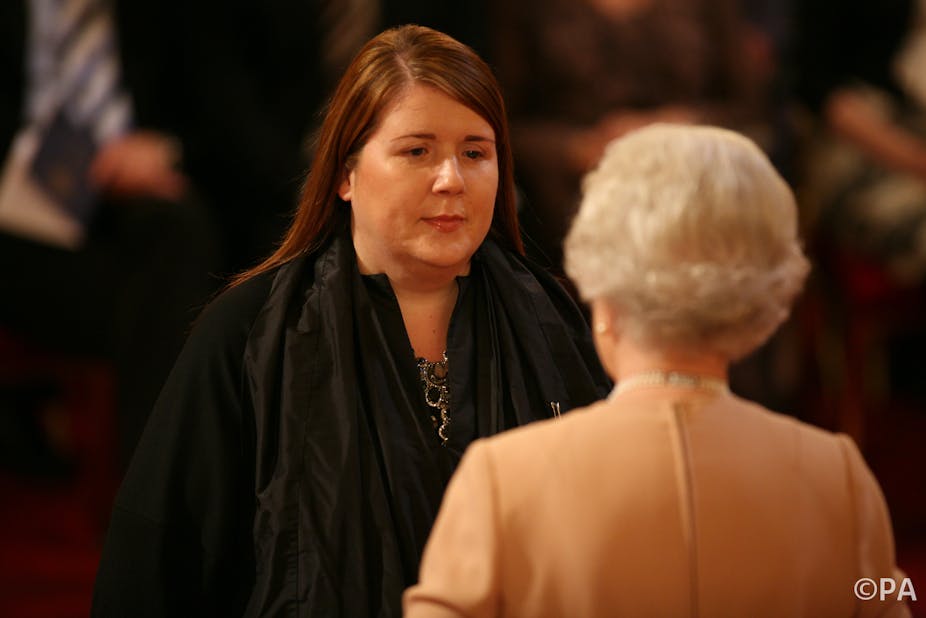The news that Louise Wilson has died held particular force for me, as someone who worked with her for ten years. She was the head of MA fashion at Central Saint Martins School of Art (CSM), and someone who shaped and nurtured the careers of top designers such as Alexander McQueen.
For the first couple of years I taught at CSM she was a distant, legendary figure. We were on different sites – this was in the mid-1990s, long before the college moved to its current King’s Cross campus. I glimpsed her only as a stern presence in the occasional meeting, at a fashion event, or, more often, heard about her in the kind of terms she is now being discussed in obituaries – as formidable, passionate and unique.
All these terms are true, as I came to know when I moved into the office opposite hers in 2001. She was all those things, and much more, and it is desperately sad that we must now hear about her remarkable talents in the past tense. That she should die so young – at 52, while visiting her sister in Scotland – is a loss to the fashion industry, and to the status and practice of fashion education in this country, as well as devastating for her family, friends, and to her colleagues.
Louise took on the role of Course Director of MA Fashion at CSM in 1992. Her achievements since then are testament to her dedication to teaching and to the industry she helped to shape. The list of designers she taught, or whose careers she helped is a roll call of British fashion – as well as Alexander McQueen, it includes Christopher Kane, Roksanda Ilincic and Stella McCartney.
She also placed students in all the major luxury and fashion design houses internationally. She understood the need for excellence, innovation and creativity, as benchmarks of great fashion. These terms are overused, but Louise knew their true meaning and understood how to achieve them, both in her own design work, for Donna Karan and others, and through challenging her students to test their skills to the limit.
Her teaching style was, to say the least, uncompromising. Students were grilled about their design choices, changes were demanded and her push to get the best from each and every one of them was relentless. I could hear her tutorials from across the corridor that separated our offices – they provided an awe-inspiring backdrop to life at CSM.
While she was invariably outspoken, her advice was aimed to prompt deeper thought, sharper skills and greater application. She expected students to behave like professionals, to dedicate themselves to finding their independent voice and to create collections that would push the discipline forward. She could spot talent and knew how to nurture it. Her exasperation during crits – when students showed her how their work was progressing – was usually linked to a suspicion that a particular student could have thought longer, considered the line more thoroughly, just done more and cared more.
Equally, Louise was animatedly pleased by those in whom she saw talent and application. I can still remember her palpable excitement – and pride — when she described the 2006 graduate show that included Christopher Kane. While she received, and deserved, many accolades, including an OBE in 2008, what drove her was her love of fashion, and her desire to inspire her students to produce the best work they possibly could. This, to me, is the essence of teaching, and of her success.
Louise tested you. She found out if you were not just absorbed by fashion, but knowledgeable enough to hold your own in a detailed discussion about its history. She was a funny, loyal and supportive colleague. I left CSM in 2006, and look back on the conversations we had as some of my favourite and most essential memories of my time there.
We shared a love of fashion photography and designers, such as Balenciaga, whose purity of vision left an indelible print on fashion history. I also always enjoyed talking to her about potential lectures. She didn’t want cold chronologies of the “greats”, or a set menu of fashion history. Rather, she would ask me what I was thinking about at the time, and as I talked – about Madeleine Vionnet and classicism or ideas about Film Noir and Guy Bourdin’s photographs – she would suddenly snap “Yes, talk about that.” I can now see that she wanted from me what she wanted from her students – the thing that was newest, most relevant to the moment, as well as to fashion’s longer evolution, and, importantly, that thing that interested and excited me most.
Louise was tireless; she devoted herself to CSM, to her students, and to fashion. She taught more than one generation of Britain’s most prominent designers, raised funding and found bursaries to train still more, and never wavered in her pursuit of the best.
And she loved London, famously returning from a stint in New York “because she missed Hackney”. She was endlessly loyal to colleagues she admired, notably, Willie Walters, Course Director of BA (Hons) Fashion and her right-hand woman Toni Tester. She was instrumental in making her alma mater CSM the international force in fashion that it is today. She was always nothing less than extraordinary, and she will be greatly missed by all those who were lucky enough to have met her.

